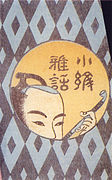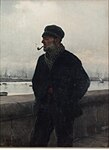Pipe smoking

Pipe smoking is the practice of tasting (or, less commonly, inhaling) the smoke produced by burning a substance, most commonly tobacco or cannabis, in a pipe. It is the oldest traditional form of smoking.
Regular pipe smoking is known to carry serious health risks including increased danger of various forms of cancer as well as pulmonary and cardiovascular illnesses.
History

A number of Native American cultures have pipe-smoking traditions, which have been part of their cultures since long before the arrival of Europeans. Tobacco is often smoked, generally for ceremonial purposes, though other mixtures of sacred herbs are also common. Various types of ceremonial pipes have been smoked in ceremony to seal covenants and treaties, most notably treaties of peace (hence the misnomer, "peace pipe"). Tobacco was introduced to Europe from the Americas in the sixteenth century and spread around the world rapidly.[1] In Asia during the nineteenth century, opium (which previously had only been eaten) was added to tobacco and smoked in pipes. Madak (the mixture of opium and tobacco) turned out to be far more addictive than orally-ingested opium, leading to social problems in China which culminated in the First (1839–1842) and Second Opium War (1856–1860).[1]
According to Alfred Dunhill, Africans have had a long tradition of smoking hemp in gourd pipes, asserting that by 1884 the King of the Baluka tribe of the Congo had established a "riamba" or hemp-smoking cult in place of fetish-worship. Enormous gourd pipes were used.[2]
In the twentieth century, pipe smoking was adopted as a preferred method of inhaling a variety of psychoactive drugs, and some claim it is a more intense method of ingestion. Smokeable crack cocaine has a reputation for being more addictive than cocaine's insufflated form. Similarly, methamphetamine has gained popularity in a crystalline form which when smoked in a pipe lets the user avoid the painful nasal irritation of snorting. When not applied to a cigarette or joint, the liquid form of PCP is typically smoked in a pipe with tobacco or cannabis.[3]
Due in no small part to successful campaigning against tobacco use, sales of pipe tobacco in Canada fell nearly 80% in a recent fifteen-year period to 27,319 kilograms in 2016, from 135,010 kilograms in 2001, according to federal data.[4] By comparison, Canadian cigarette sales fell about 32% in the same period to 28,600,000,000 units.[5]
Pipes

Pipes have been fashioned from an assortment of materials including briar, clay, ceramic, corncob, glass, meerschaum, metal, gourd, stone, wood, bog oak and various combinations thereof, most notably, the classic English calabash pipe.
The size of a pipe, particularly the bowl, depends largely on what is intended to be smoked in it. Large western-style tobacco pipes are used for strong-tasting, harsh tobaccos, the smoke from which is usually not inhaled. Smaller pipes such as the midwakh or kiseru are used to inhale milder tobaccos such as dokha and kizami or other substances such as cannabis and opium.
Water pipes
Water pipes bubble smoke through water to cool and wash the smoke. The two basic types are stationary hookahs, with one or more long flexible drawtubes, and portable bongs.
Spoon pipes
Spoon pipes (glass pipes or glass bowl pipes) have become increasingly common with the rise of cannabis or other narcotics smoking. Spoon pipes are normally made of borosilicate glass to withstand repeated exposure to high temperatures. They consist of a bowl for packing material into, stem for inhaling, and a carburettor (carb) for controlling suction and airflow into the pipe. These pipes utilize a two step process. First, the user inhales while lighting the smoking material and holding down the carb, allowing smoke to fill the stem. Then, the user releases the carb while inhaling to allow air to enter the stem and smoke to be pulled into the user's mouth.
Health effects
The overall health risks are 10% higher in pipe smokers than in non-smokers.[6] However, pipe or cigar smokers who are former-cigarette smokers might retain a habit of smoke inhalation.[6] In such cases, there is a 30% increase in the risk of heart disease and a nearly three times greater risk of developing COPD.[6] In addition, there is a causal relationship between pipe smoking and mortality due to lung and other cancers, as well as periodontal problems, such as tooth and bone loss.[6]
However, all tobacco products deliver nicotine to the central nervous system, and there is a confirmed risk of dependence. Many forms of tobacco use are associated with a significantly increased risk of morbidity and premature mortality due to tobacco-related diseases.[6]
Culture

The customs, vocabulary and etiquette that surround pipe smoking culture vary across the world and depend both on the people who are smoking and the substance being smoked.
For example, in many places in Europe and North America, tobacco pipe smoking has sometimes been seen as genteel or dignified and has given rise to a variety of customized accessories and even apparel such as the smoking jacket, and the former Pipe Smoker of the Year award in the UK, as well as the term kapnismology ("the study of smoke").[7]
Notable pipe smokers
A number of people and fictional characters are strongly associated with the hobby of pipe smoking.
People who smoke pipes
- Sparky Anderson, American baseball manager.[8]
- Vicente Battista, Argentine writer.[9]
- Enzo Bearzot, manager of the 1982 FIFA World Cup Champion Italy national football team.[10]
- Rómulo Betancourt (1908–1981), President of Venezuela.[9]
- Clarence "Gatemouth" Brown, American blues musician. An avid pipe smoker, the Texas-blues guitarist often sold his own proprietary blend of pipe tobacco as well as autographed pipes at his concerts and shows.[11]
- Abelardo Castillo, Argentine writer.[9]
- Julio Cortázar, Argentine writer.[9]
- Edward VIII, short-reigned (20 January – 11 December 1936) King of the United Kingdom.[12]
- William Faulkner, American author, known to be an enthusiastic proponent of pipe smoking.[13]
- Manuel Felguérez, Mexican artist.[9]
- Gerald R. Ford (1913–2006), 38th President of the United States from 1974 to 1977.[14]
- Che Guevara (1928–1967), Argentinian revolutionary, who was known to enjoy a pipe from time to time, in addition to his usual cigar.[9]
- Herbert Hoover (1874–1964), 31st President of the United States (1928–1933).[15]
- John N. Mitchell (1913–1988), 67th Attorney General of the United States (1969–1972) under President Richard Nixon.[16]
- Charles Stewart Mott, GM executive, philanthropist, Flint Mayor.[17]
- Pablo Neruda, Chilean poet.[9]
- Helmut Schmidt (1918–2015), Chancellor of West Germany (1974–1982).[16]
- Joseph Stalin (1878–1953), Premier of the USSR. He was frequently shown with a pipe: "Photos of him appeared daily in the Soviet press, now in genial pipe-smoking profile, now walking with his comrades..."[18]
- Mark Twain (1835–1910), American author, a.k.a. Samuel Clemens, writer of Huckleberry Finn favored Missouri Meershaum corncob pipes. He was notoriously partial to a special blend of "Cuban leaf" pipe tobacco, remarking once that "If I cannot smoke in heaven, then I shall not go."[19]
- Harold Wilson (1916–1995), UK Prime Minister (1964–1970, 1974–1976).[16]

Fictional characters who smoke pipes
- Bacicci, a sailor whose silhouette is featured on U.C. Sampdoria's club crest.[20]
- Roger, Pongo's owner in 101 Dalmatians.[21]
- Sherlock Holmes, British literary character. He is explicitly described as a pipe smoker.[22]
- Kapitein Rob, Dutch comics character.[23]
More examples can be found in the Pipe Smoker of the Year list.
Gallery
- Click on image for larger view
-
Gerrit Dou: self-portrait with long-stemmed clay pipe (1645)
-
Man smoking kiseru. Cover illustration of the novel Komon gawa ("Elegant chats on fabric design") by Santō Kyōden, 1790
-
Georgian composer, Meliton Balanchivadze smoking pipe
-
Tiger smoking a bamboo pipe, Korean folk painting from Joseon period
-
Arab man smoking pipe, late 1800s
-
Various styles of Native American ceremonial pipes
-
Lord Wilson
-
Model, 1894
by Francesc Galofré i Oller -
Portrait of a fisherman, 1890
by Dionisio Baixeras i Veraguer -
Portrait of a Muslim, 1880
by Simó Gómez -
Aarre Merikanto, a Finnish composer, smoking pipe in 1950s
See also
For tobacco products
For cannabis
Other substances
References
- ^ a b "pipe smoking". The Columbia Encyclopedia, Sixth Edition. Bartleby.com. Archived from the original on August 29, 2008.
- ^ Dunhill, Alfred, The Pipe Book Archived 2017-10-11 at the Wayback Machine, London, A & C Black, 1924
- ^ "National Trends in Drug Abuse". Archived from the original on 2006-12-31. Retrieved 2006-12-10.
- ^ Health Canada (September 19, 2017). "Page 5: National and provincial/territorial tobacco sales data 2019". www.canada.ca. Archived from the original on December 11, 2017. Retrieved December 11, 2017.
- ^ Health Canada (September 18, 2017). "Page 2: National and provincial/territorial tobacco sales data 2019". www.canada.ca. Archived from the original on December 11, 2017. Retrieved December 11, 2017.
- ^ a b c d e Viegas CA (2008). "Noncigarette forms of tobacco use". J Bras Pneumol. 34 (12): 1069–73. doi:10.1590/S1806-37132008001200013. PMID 19180343.
- ^ "Origin of kapnismology".
- ^ Madden, Bill. "Sparky Anderson, a great manager with great stories, saw welcome wear thin with Reds and Tigers". New York Daily News. Archived from the original on 2017-10-11. Retrieved 2021-10-06.
- ^ a b c d e f g "Día Mundial de la Pipa, iberoamericanos famosos que popularizaron este sofisticado objeto para fumar". Notimérica (in Spanish). 2017-02-20. Retrieved 2022-01-15.
- ^ Bell, Jack. "Enzo Bearzot, Who Coached Italy to Cup Title, Dies at 83," The New York Times, Wednesday, December 22, 2010. Retrieved October 30, 2021
- ^ Edwards, Martin. "It All Comes Back". Pipes & Tobacco magazine, Spring 2002. pp. 14–17.
- ^ "50+ Amazing Tobacco Pipe Shapes Explained - [Infographic]". www.tobaccopipes.com. Archived from the original on 2021-03-05. Retrieved 2021-10-06.
- ^ Graves, K. Maxwell Jr. "Pipe Smoking Friends - Famous and Infamous". Pipes & Tobacco magazine, Summer 2002. pp. 28–30.
- ^ "The Briar Files: A blog about pipes and pipe smoking". 14 November 2009. Archived from the original on 5 February 2015. Retrieved 15 November 2013.
- ^ "Pipes, People and Dealing with Stress". PipesMagazine.com. 1 July 2009. Archived from the original on 11 August 2014. Retrieved 16 November 2013.
- ^ a b c "Famous Pipe Smokers". Alt Smokers Pipe. Archived from the original on 10 June 2015. Retrieved 16 November 2013.
- ^ Gatlin, Karen (July 12, 2011). "One of downtown Flint's oldest businesses turns 83". ABC11 Raleigh-Durham. ABC12. Archived from the original on October 11, 2017. Retrieved May 9, 2017.
- ^ Tucker, Robert C. (1 January 1992). Stalin in Power: The Revolution from Above, 1928-1941. W. W. Norton & Company. ISBN 9780393308693. Archived from the original on 6 October 2021. Retrieved 2 December 2020 – via Google Books.
- ^ "Mark Twain on Pipe Smoking". Archived from the original on 2013-05-16. Retrieved 2013-03-07.
- ^ Motherby, Les (2018-11-26). "A history of Sampdoria's 'Baciccia' crest". Museum of Jerseys. Retrieved 2021-10-30.
- ^ Media, Australian Council on Children and the. "One Hundred and One Dalmatians". Raising Children Network. Retrieved 2024-09-11.
- ^ A Sherlock Holmes related bibliography Archived 2009-09-05 at the Wayback Machine, includes quite a few articles devoted to smoking habits of Mr. Holmes
- ^ "Pieter Kuhn". lambiek.net. Archived from the original on 2016-04-16. Retrieved 2016-09-21.
External links
- Pipes: Logos & Markings: Pipe brands by pictures.
- Pipe Smoking: A history of pipe smoking and its modern-day practice.
- Webarchive template wayback links
- CS1 Spanish-language sources (es)
- Articles with short description
- Short description is different from Wikidata
- Articles needing additional references from January 2022
- All articles needing additional references
- Pages using Sister project links with default search
- Pipe smoking
- Tobacciana








![Model, 1894 by Francesc Galofré i Oller [ca]](http://upload.wikimedia.org/wikipedia/commons/thumb/d/d4/Francesc_Galofr%C3%A9_i_Oller-_Un_model-_251.JPG/92px-Francesc_Galofr%C3%A9_i_Oller-_Un_model-_251.JPG)


